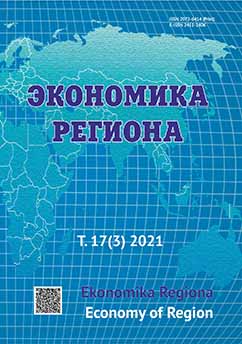Regional Innovation Systems in Poland: How to classify them?
Regional Innovation Systems in Poland: How to classify them?
Author(s): Dorota Ciołek, Anna Golejewska, Adrianna Zabłocka-Abi YaghiSubject(s): Social Sciences, Economy, Geography, Regional studies, National Economy, Regional Geography, Financial Markets
Published by: Институт экономики Уральского отделения Российской академии наук
Keywords: regional economics; Regional Innovation System; innovation inputs; innovation outputs; metropolitan NUTS 3; non-metropolitan NUTS 3; classification; panel data; cluster analysis; Poland;
Summary/Abstract: The literature emphasises the role of regional and local innovation environment. Regional Innovation Systems show differences in innovation outputs determined by different inputs. Understanding these relationships can have important implications for regional and innovation policy. The research aims to classify Regional Innovation Systems in Poland according to their innovation capacity and performance. The analysis covers 72 subregions (classified as NUTS 3 in the Nomenclature of Territorial Units for Statistics) in 2004–2016. Classes of Regional Innovation Systems in Poland were identified based on a combination of linear and functional approaches and data from published and unpublished sources. It was assumed that innovation systems in Poland differ due to their location in metropolitan and non-metropolitan regions, thus, the Eurostat NUTS 3 metro/non-metro typology was applied for this purpose. Panel data regressions as models with individual random effects were estimated separately for metropolitan and non-metropolitan groups of subregions. The study identified common determinants of innovation outputs in both NUTS 3 types: share of innovative industrial enterprises, industry share, unemployment rate, and employment in research and development. Next, NUTS 3 were classified within each of two analysed types in line with output- and input-indices, the latter being calculated as non-weighted average of significant inputs. Last, the subregions were clustered based on individual inputs to enable a more detailed assessment of their innovation potential. The cluster analysis using k-means method with maximum cluster distance was applied. The results showed that the composition of the classes identified within metropolitan and non-metropolitan systems in 2004– 2016 remains unstable, similarly to the composition of clusters identified by inputs. The latter confirms the changes in components of the capacity within both Regional Innovation System types. The observed situation allows us to assume that Regional Innovation Systems in Poland are evolving. In further research, the efficiency of Regional Innovation Systems should be assessed, taking into account the differences between metropolitan and non-metropolitan regions as well as other environmental factors that may determine the efficiency of innovative processes
Journal: Экономика региона
- Issue Year: 17/2021
- Issue No: 3
- Page Range: 987-1003
- Page Count: 17
- Language: English

